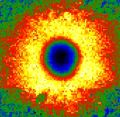Speaker
Description
Motivation: Current silicon-based production methods for modern energy-harvesting systems and other electronics fall short of low-cost fabrication requirements. The future of commercializing flexible and printed electronics lies in rapid, cost-effective roll-to-roll manufacturing, which necessitates the use of flexible, inexpensive substrates like PET, PEN, and, more recently, eco-friendly materials such as nano-paper. The temperature during each step of fabrication is critical with these materials, generally not exceeding 150 °C. Low-temperature plasma offers a promising solution for advancing future manufacturing techniques.
Atmospheric plasma: We introduce a proprietary, large-area plasma with an extremely high power density of up to 100 W.cm-3, capable of producing diffuse, homogeneous, and cold plasma (<70 °C) in open air and various gases like nitrogen, argon, and methane. This plasma, displayed in Fig. 1, operates at low temperatures yet has enough energy to modify the surfaces of nanostructured materials and semiconductors, including graphene oxide and titanium dioxide, altering their crystallinity, optoelectronics, and wettability. The plasma’s low temperature and rapid treatment times (1–10 s) make it suitable for integration into roll-to-roll manufacturing, enhancing the commercial viability of flexible and printed electronics.
Perovskite solar cells: In our poster, we display several applications of plasma in the production of perovskite solar cells. Examples include: (i) plasma treatment of indium-tin-oxide electrodes as a fast substitute for the extensive chemical treatment needed prior to depositing conductive films, and (ii) plasma processing of mesoporous titanium dioxide electron transport layers, which provides a rapid, low-temperature alternative to conventional high-temperature sintering.
Acknowledgment: This work was supported by the project LM2023039 funded by the Ministry of Education, Youth and Sports of the Czech Republic.

